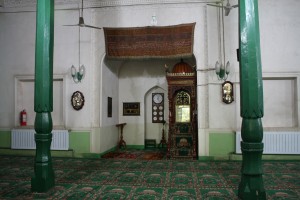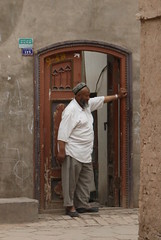Hajji Mosque in Geokdepe
This afternoon we ventured out of Ashgabat to see the museum to the Turkmen’s last stand against the Russians. 15,000 men, women and children were massacred and the site was turned into a collective farm during Soviet times. Today the site is protected, and one can see soft ruins in the distance which are unreachable. In lieu of seeing the actual ruins one can check out the museum, which is a majestic work of art containing actual artifacts from the site as well as countless artist recreations of the massacre scene.
In the same parking lot as the massacre museum lies the Saparmurat Hajji Mosque seating 8,000 visitors. The mosque is unlike any other on earth. The former president Niyazov made his pilgrimage to Mecca and received US $10 billion in aid from the Saudis to put towards furthering Islam in Turkmenistan. Niyazov returned to Turkmenistan and erected this futuristic mosque, with quotes from the Koran intermingled with quotes from Niyazov’s own book, the Ruhnama. The centerpiece script said, “The Ruhnama is a holy book, the Koran is Allah’s book.” Niyazov insisted all Turkmen visit the mosque once a year, but that command was only loosely followed.
After touring the museum and mosque, we left with a surreal feeling, which we interpreted as hunger. Chuli Valley, outside Ashgabat , is an oasis in this otherwise sandy country. The green valley extends for less than two miles, but was well worth the visit. A restaurant in the valley served kebabs, fries and cold beer, so we eagerly partook as peacocks wandered underfoot. Sitting there stunned by what we’d seen, both in the massacre museum and the absurdity that was the mosque, we realized that Turkmenistan really is more aptly called absurdistan.


